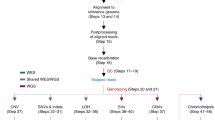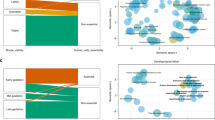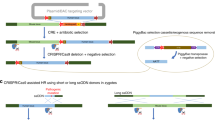Abstract
In the post-genome era, the mouse will have a major role as a model system for functional genome analysis. This requires a large number of mutants similar to the collections available from other model organisms such as Drosophila melanogaster and Caenorhabditis elegans. Here we report on a systematic, genome-wide, mutagenesis screen in mice. As part of the German Human Genome Project, we have undertaken a large-scale ENU-mutagenesis screen for dominant mutations and a limited screen for recessive mutations1. In screening over 14,000 mice for a large number of clinically relevant parameters, we recovered 182 mouse mutants for a variety of phenotypes. In addition, 247 variant mouse mutants are currently in genetic confirmation testing and will result in additional new mutant lines. This mutagenesis screen, along with the screen described in the accompanying paper2, leads to a significant increase in the number of mouse models3 available to the scientific community. Our mutant lines are freely accessible to non-commercial users (for information, see http://www.gsf.de/ieg/groups/enu-mouse.html).
This is a preview of subscription content, access via your institution
Access options
Subscribe to this journal
Receive 12 print issues and online access
$209.00 per year
only $17.42 per issue
Buy this article
- Purchase on Springer Link
- Instant access to full article PDF
Prices may be subject to local taxes which are calculated during checkout




Similar content being viewed by others
References
Hrabé de Angelis, M. & Balling, R. Large scale ENU screens in the mouse. Genetics meets genomics. Mutat. Res. 400, 25–32 (1998).
Nolan, P.M. et al. A systematic, genome-wide, phenotype-driven mutagenesis program for gene function studies in the mouse. Nature Genet. 25, 440–443 (2000).
Brown, S. & Peters, J. Combining mutagenesis and genomics in the mouse—closing the phenotype gap. Trends Genet. 12, 433–435 (1996).
Graw, J. et al. Mutation in the bA3/A1-crystallin encoding gene Cryba1 causes a dominant cataract in the mouse. Genomics 62, 67–73 (1999)
Marschall, S. & Hrabé de Angelis, M. Cryopreservation of mouse spermatozoa–double your mouse space. Trends Genet. 15, 128–131 (1999).
Marschall, S., Huffstadt, U., Balling, R. & Hrabé de Angelis, M. Reliable recovery of inbred mouse lines using cryopreserved spermatozoa. Mamm. Genome 10, 773–776 (1999).
Whyte, M.P., Teitelbaum, S.L., Murphy, W.A., Bergfeld, M.A. & Avioli, L.V. Adult hypophosphatasia. Clinical, laboratory, and genetic investigation of a large kindred with review of the literature. Medicine 58, 329–347 (1979).
Spickett, G.P. et al. Common variable immunodeficiency: how many diseases? Immunol. Today 18, 325–328 (1997).
Ahearn, J.M. et al. Disruption of the Cr2 locus results in a reduction in B-1a cells and in an impaired B cell response to T-dependent antigen. Immunity 4, 251–262 (1996).
Molina, H. et al. Markedly impaired humoral immune response in mice deficient in complement receptors 1 and 2. Proc. Natl Acad. Sci. USA 93, 3357–3361 (1996).
Russell, W.L. et al. Specific-locus test shows ethylnitrosourea to be the most potent mutagen in the mouse. Proc. Natl Acad. Sci. USA 76, 5918–5922 (1979).
Justice, M.J., Noveroske, J.K., Weber, J.S., Zheng, B. & Bradley, A. Mouse ENU mutagenesis. Hum. Mol. Genet. 8, 1955–1963 (1999).
Nolan, P.M., Kampfhamer, D. & Bucan, M. Random mutagenesis screen for dominant behavioral mutations in mice. Methods 13, 379–395 (1997).
Acknowledgements
We thank A. Servatius, S. Prettin, G. Bergter, N. Hirsch, A. Mayer, S. Manz, S. Hoffmann, F. Golla, B. Beneckenstein, K. Lobenwein, A. Wolf and D. Kreitz for technical assistance; C. Schindewolf for comments and revision of the manuscript; and H. Wagner for support. Part of this project was supported by grants from the German Human Genome Project to R.B., E.W. and M.H.d.A. (01KW9610/1), and to K.P., J.R. and H.B. (01KW9636).
Author information
Authors and Affiliations
Corresponding author
Supplementary information
Rights and permissions
About this article
Cite this article
de Angelis, M., Flaswinkel, H., Fuchs, H. et al. Genome-wide, large-scale production of mutant mice by ENU mutagenesis. Nat Genet 25, 444–447 (2000). https://doi.org/10.1038/78146
Received:
Accepted:
Issue Date:
DOI: https://doi.org/10.1038/78146
This article is cited by
-
Genetically modified mice as a tool for the study of human diseases
Molecular Biology Reports (2024)
-
Mutations within the cGMP-binding domain of CNGA1 causing autosomal recessive retinitis pigmentosa in human and animal model
Cell Death Discovery (2022)
-
Progress towards completing the mutant mouse null resource
Mammalian Genome (2022)
-
gom1 Mutant Mice as a Model of Otitis Media
Journal of the Association for Research in Otolaryngology (2022)
-
The virtuous cycle of human genetics and mouse models in drug discovery
Nature Reviews Drug Discovery (2019)



